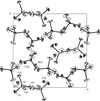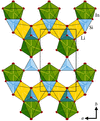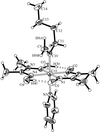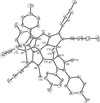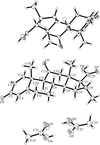issue contents
May 2003 issue

Cover illustration: The packing of the hydrocarbon chains in the crystal structure of (4S,5S)-4-[(1R)-1,2-dihydroxyethyl]-5-tridecyl-1,3-oxazolidin-2-one, with alternating layers of carbon tails and oxazolidin-2-one head groups. See Sawatzki, Mikeska, Nieger, Bolte & Kolter [Acta Cryst. (2003), C59, o225-o227].
inorganic compounds
Download citation


Download citation


Crystals of (NH4)2ZrGe3O9, a new zirconogermanate analogue of wadeite, were hydrothermally synthesized using ZrO(NO3)2·2H2O as the source of Zr. The framework structure is built up of cyclic trigermanate units crosslinked by ZrO6 octahedra. Two ammonium cations are located in each of the large cages.
Download citation


Download citation


Rb2Cd2(SO4)3 is a type I langbeinite. As in any langbeinite-type structure, the Rb+ ions are surrounded by nine O atoms, forming irregular polyhedra. Each Cd2+ ion is coordinated by six O atoms in the form of a distorted octahedron, where each O atom belongs to a different sulfate ion.
Download citation


Download citation


Crystals of titanium-doped distrontium ruthenium tetraoxide, Sr2Ru1−xTixO4, with x = 0.07 and 0.19, were grown by floating-zone melting. Increasing Ti content leads to a distinctive systematic variation of cell parameters and interatomic distances with respect to the undoped material.
Download citation


Download citation


The structure of the olivine LiInSiO4 (lithium indium silicate) is isotypic with LiScSiO4 and MgMgSiO4 (forsterite). The main differences between the title compound and the divalent–divalent olivines are found for bond lengths and angles opposite common edges between the tetrahedron and the Li+ and In3+ ion sites.
metal-organic compounds
Download citation


Download citation


Download citation


Download citation


Download citation


Download citation


Download citation


Download citation


Download citation


Download citation


Download citation


Download citation


Download citation


Download citation


Download citation


Download citation


Download citation


Download citation


Download citation


Download citation


Download citation


Download citation


Download citation


Download citation


Download citation


Download citation


Download citation


Download citation


organic compounds
Download citation


Download citation


Download citation


Download citation


Download citation


Download citation


Download citation


Download citation


Download citation


Download citation


Download citation


Download citation


Download citation


Download citation


Download citation


Download citation


Download citation


Download citation


Download citation


Download citation


Download citation


Download citation


Download citation


Download citation


Download citation


Download citation


Download citation


Download citation


Download citation


Download citation


Download citation


Download citation


Download citation


Download citation


Download citation


Download citation




 journal menu
journal menu












